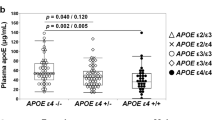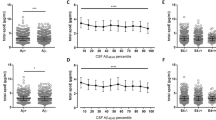Abstract
The apolipoprotein E (ApoE) ε4 allele is the strongest risk factor of sporadic Alzheimer’s disease (AD), however, the fluid concentrations of ApoE and its different isoforms (ApoE2, ApoE3 and ApoE4) in AD patients and among APOE genotypes (APOE ε2, ε3, ε4) remain controversial. Using a novel mass spectrometry-based method, we quantified total ApoE and specific ApoE isoform concentrations and potential associations with age, cognitive status, cholesterol levels and established AD biomarkers in cerebrospinal fluid (CSF) from AD patients versus non-AD individuals with different APOE genotypes. We also investigated plasma total ApoE and ApoE isoform composition in a subset of these individuals. In total n = 43 AD and n = 43 non-AD subjects were included. We found that CSF and plasma total ApoE levels did not correlate with age or cognitive status and did not differ between AD and non-AD subjects deeming ApoE as an unfit diagnostic marker for AD. Also, whereas CSF ApoE levels did not vary between APOE genotypes APOE ε4 carriers exhibited significantly decreased plasma ApoE levels attributed to a specific decrease in the ApoE4 isoform concentrations. CSF total ApoE concentrations were positively associated with CSF, total tau, tau phosphorylated at Thr181 and Aβ1-42 of which the latter association was weaker and only present in APOE ε4 carriers indicating a differential involvement of ApoE in tau versus Aβ-linked neuropathological processes. Future studies need to elucidate whether the observed plasma ApoE4 deficiency is a life-long condition in APOE ɛ4 carriers and whether this decrease in plasma ApoE predisposes APOE ɛ4 carriers to AD.


Similar content being viewed by others
Abbreviations
- Aβ:
-
Amyloid-β
- AD:
-
Alzheimer’s disease
- ApoE:
-
Apolipoprotein E
- BBB:
-
Blood–brain barrier
- CNS:
-
Central nervous system
- CSF:
-
Cerebrospinal fluid
- HDL:
-
High-density lipoprotein
- LDL:
-
Low-density lipoprotein
- MMSE:
-
Mini-mental state examination
- QAlb:
-
CSF/plasma albumin ratio
- SNP:
-
Single nucleotide polymorphism
- T-tau:
-
Total tau
- P-tau:
-
Tau phosphorylated at Thr181
References
Blennow K, Fredman P, Wallin A et al (1993) Protein analysis in cerebrospinal fluid. II. Reference values derived from healthy individuals 18–88 years of age. Eur Neurol 33:129–133
Blennow K, Wallin A, Agren H, Spenger C, Siegfried J, Vanmechelen E (1995) Tau protein in cerebrospinal fluid: a biochemical marker for axonal degeneration in Alzheimer disease? Mol Chem Neuropathol 26:231–245. doi:10.1007/BF02815140
Castellano JM, Kim J, Stewart FR et al (2011) Human apoE isoforms differentially regulate brain amyloid-beta peptide clearance. Sci Transl Med 3:89ra57. doi:10.1126/scitranslmed.3002156
Corder EH, Saunders AM, Risch NJ et al (1994) Protective effect of apolipoprotein E type 2 allele for late onset Alzheimer disease. Nat Genet 7:180–184
Cramer PE, Cirrito JR, Wesson DW et al (2012) ApoE-directed therapeutics rapidly clear beta-amyloid and reverse deficits in AD mouse models. Science 335:1503–1506. doi:10.1126/science.1217697
Cruchaga C, Kauwe JS, Nowotny P et al (2012) Cerebrospinal fluid APOE levels: an endophenotype for genetic studies for Alzheimer’s disease. Hum Mol Genet 21:4558–4571. doi:10.1093/hmg/dds296
Darreh-Shori T, Forsberg A, Modiri N et al (2011) Differential levels of apolipoprotein E and butyrylcholinesterase show strong association with pathological signs of Alzheimer’s disease in the brain in vivo. Neurobiol Aging 32(2320):e2315–e2332. doi:10.1016/j.neurobiolaging.2010.04.028
Fagan AM, Mintun MA, Mach RH et al (2006) Inverse relation between in vivo amyloid imaging load and cerebrospinal fluid Abeta42 in humans. Ann Neurol 59:512–519. doi:10.1002/ana.20730
Farrer LA, Cupples LA, Haines JL et al (1997) Effects of age, sex, and ethnicity on the association between apolipoprotein E genotype and Alzheimer disease. A meta-analysis. APOE and Alzheimer disease meta analysis consortium. JAMA 278:1349–1356
Gregg RE, Zech LA, Schaefer EJ, Stark D, Wilson D, Brewer HB Jr (1986) Abnormal in vivo metabolism of apolipoprotein E4 in humans. J Clin Invest 78:815–821. doi:10.1172/JCI112645
Gupta VB, Laws SM, Villemagne VL et al (2011) Plasma apolipoprotein E and Alzheimer disease risk: the AIBL study of aging. Neurology 76:1091–1098. doi:10.1212/WNL.0b013e318211c352
Hatters DM, Peters-Libeu CA, Weisgraber KH (2006) Apolipoprotein E structure: insights into function. Trends Biochem Sci 31:445–454. doi:10.1016/j.tibs.2006.06.008
Hegele RA (2009) Plasma lipoproteins: genetic influences and clinical implications. Nat Rev Genet 10:109–121. doi:10.1038/nrg2481
Hixson JE, Vernier DT (1990) Restriction isotyping of human apolipoprotein E by gene amplification and cleavage with HhaI. J Lipid Res 31:545–548
Hudry E, Dashkoff J, Roe AD et al (2013) Gene transfer of human apoe isoforms results in differential modulation of amyloid deposition and neurotoxicity in mouse brain. Sci Transl Med 5:212ra161. doi:10.1126/scitranslmed.3007000
Kok E, Haikonen S, Luoto T et al (2009) Apolipoprotein E-dependent accumulation of Alzheimer disease-related lesions begins in middle age. Ann Neurol 65:650–657. doi:10.1002/ana.21696
LaClair KD, Manaye KF, Lee DL et al (2013) Treatment with bexarotene, a compound that increases apolipoprotein-E, provides no cognitive benefit in mutant APP/PS1 mice. Mol Neurodegener 8:18. doi:10.1186/1750-1326-8-18
Lahoz C, Schaefer EJ, Cupples LA et al (2001) Apolipoprotein E genotype and cardiovascular disease in the Framingham Heart Study. Atherosclerosis 154:529–537. doi:10.1016/S0021-9150(00)00570-0
Linton MF, Gish R, Hubl ST et al (1991) Phenotypes of apolipoprotein B and apolipoprotein E after liver transplantation. J Clin Invest 88:270–281. doi:10.1172/JCI115288
Liu CC, Kanekiyo T, Xu H, Bu G (2013) Apolipoprotein E and Alzheimer disease: risk, mechanisms and therapy. Nat Rev Neurol 9:106–118. doi:10.1038/nrneurol.2012.263
Liu M, Kuhel DG, Shen L, Hui DY, Woods SC (2012) Apolipoprotein E does not cross the blood-cerebrospinal fluid barrier, as revealed by an improved technique for sampling CSF from mice. Am J Physiol Regul Integr Comp Physiol 303:R903–R908. doi:10.1152/ajpregu.00219.2012
Ly S, Altman R, Petrlova J et al (2013) Binding of apolipoprotein E inhibits the oligomer growth of amyloid-beta peptide in solution as determined by fluorescence cross-correlation spectroscopy. J Biol Chem 288:11628–11635. doi:10.1074/jbc.M112.411900
Mahley RW, Rall SC Jr (2000) Apolipoprotein E: far more than a lipid transport protein. Annu Rev Genomics Hum Genet 1:507–537. doi:10.1146/annurev.genom.1.1.507
Mahley RW, Weisgraber KH, Huang Y (2009) Apolipoprotein E: structure determines function, from atherosclerosis to Alzheimer’s disease to AIDS. J Lipid Res 50(Suppl):S183–S188. doi:10.1194/jlr.R800069-JLR200
Martinez-Morillo E, Nielsen HM, Batruch I et al (2014) Assessment of Peptide chemical modifications on the development of an accurate and precise multiplex selected reaction monitoring assay for apolipoprotein e isoforms. J Proteome Res 13:1077–1087. doi:10.1021/pr401060x
McKhann G, Drachman D, Folstein M, Katzman R, Price D, Stadlan EM (1984) Clinical diagnosis of Alzheimer’s disease: report of the NINCDS-ADRDA Work Group under the auspices of Department of Health and Human Services Task Force on Alzheimer’s disease. Neurology 34:939–944
McKhann G (1987) Diagnostics and statistical manual of mental disorders. American Psychiatric Association, Arlington
Mooijaart SP, Berbee JF, van Heemst D et al (2006) ApoE plasma levels and risk of cardiovascular mortality in old age. PLoS Med 3: e176. doi:10.1371/journal.pmed.0030176
Mulder SD, Nielsen HM, Blankenstein MA, Eikelenboom P, Veerhuis R (2014) Apolipoproteins E and J interfere with amyloid-beta uptake by primary human astrocytes and microglia in vitro. Glia 62:493–503. doi:10.1002/glia.22619
Nielsen HM, Mulder SD, Belien JA, Musters RJ, Eikelenboom P, Veerhuis R (2010) Astrocytic A beta 1-42 uptake is determined by A beta-aggregation state and the presence of amyloid-associated proteins. Glia 58:1235–1246. doi:10.1002/glia.21004
Riddell DR, Zhou H, Atchison K et al (2008) Impact of apolipoprotein E (ApoE) polymorphism on brain ApoE levels. J Neurosci 28:11445–11453
Rosen C, Hansson O, Blennow K, Zetterberg H (2013) Fluid biomarkers in Alzheimer’s disease—current concepts. Mol Neurodegener 8:20. doi:10.1186/1750-1326-8-20
Sanan DA, Weisgraber KH, Russell SJ et al (1994) Apolipoprotein E associates with beta amyloid peptide of Alzheimer’s disease to form novel monofibrils. Isoform apoE4 associates more efficiently than apoE3. J Clin Invest 94:860–869. doi:10.1172/JCI117407
Schmidt C, Becker H, Zerr I (2014) Cerebrospinal fluid apolipoprotein e concentration and severity of cognitive impairment in patients with newly diagnosed Alzheimer’s disease. Am J Alzheimers Dis Other Demen 29:54–60. doi:10.1177/1533317513505133
Shinohara M, Petersen RC, Dickson DW, Bu G (2013) Brain regional correlation of amyloid-beta with synapses and apolipoprotein E in non-demented individuals: potential mechanisms underlying regional vulnerability to amyloid-beta accumulation. Acta Neuropathol 125:535–547. doi:10.1007/s00401-013-1086-9
Simon R, Girod M, Fonbonne C et al (2012) Total ApoE and ApoE4 isoform assays in an Alzheimer’s disease case-control study by targeted mass spectrometry (n = 669): a pilot assay for methionine-containing proteotypic peptides. Mol Cell Proteomics 11:1389–1403. doi:10.1074/mcp.M112.018861
Small BJ, Rosnick CB, Fratiglioni L, Backman L (2004) Apolipoprotein E and cognitive performance: a meta-analysis. Psychol Aging 19:592–600. doi:10.1037/0882-7974.19.4.592
Smit M, de Knijff P, Rosseneu M et al (1988) Apolipoprotein E polymorphism in The Netherlands and its effect on plasma lipid and apolipoprotein levels. Hum Genet 80:287–292
Song F, Poljak A, Crawford J et al (2012) Plasma apolipoprotein levels are associated with cognitive status and decline in a community cohort of older individuals. PLoS ONE 7:e34078. doi:10.1371/journal.pone.0034078
Toledo JB, Da X, Weiner MW et al (2014) CSF Apo-E levels associate with cognitive decline and MRI changes. Acta Neuropathol. doi:10.1007/s00401-013-1236-0
Tsuang D, Leverenz JB, Lopez OL et al (2013) APOE epsilon4 increases risk for dementia in pure synucleinopathies. JAMA Neurol 70:223–228. doi:10.1001/jamaneurol.2013.600
Vance JE, Hayashi H (2010) Formation and function of apolipoprotein E-containing lipoproteins in the nervous system. Biochim Biophys Acta 1801:806–818. doi:10.1016/j.bbalip.2010.02.007
Vanderstichele H, Van Kerschaver E, Hesse C et al (2000) Standardization of measurement of beta-amyloid(1-42) in cerebrospinal fluid and plasma. Amyloid 7:245–258
Vanmechelen E, Vanderstichele H, Davidsson P et al (2000) Quantification of tau phosphorylated at threonine 181 in human cerebrospinal fluid: a sandwich ELISA with a synthetic phosphopeptide for standardization. Neurosci Lett 285:49–52. doi:10.1016/S0304-3940(00)01036-3
Veerhuis R, Boshuizen RS, Familian A (2005) Amyloid associated proteins in Alzheimer’s and prion disease. Curr Drug Targets CNS Neurol Disord 4:235–248
Verghese PB, Castellano JM, Holtzman DM (2011) Apolipoprotein E in Alzheimer’s disease and other neurological disorders. Lancet Neurol 10:241–252. doi:10.1016/S1474-4422(10)70325-2
Verghese PB, Castellano JM, Garai K et al (2013) ApoE influences amyloid-beta (Abeta) clearance despite minimal apoE/Abeta association in physiological conditions. Proc Natl Acad Sci USA 110:E1807–E1816. doi:10.1073/pnas.1220484110
Ward A, Crean S, Mercaldi CJ et al (2012) Prevalence of apolipoprotein E4 genotype and homozygotes (APOE e4/4) among patients diagnosed with Alzheimer’s disease: a systematic review and meta-analysis. Neuroepidemiology 38:1–17. doi:10.1159/000334607
Wennstrom M, Surova Y, Hall S et al (2013) Low CSF levels of both alpha-synuclein and the alpha-synuclein cleaving enzyme neurosin in patients with synucleinopathy. PLoS ONE 8:e53250. doi:10.1371/journal.pone.0053250
Wildsmith KR, Basak JM, Patterson BW et al (2012) In vivo human apolipoprotein E isoform fractional turnover rates in the CNS. PLoS ONE 7:e38013. doi:10.1371/journal.pone.0038013
Zlokovic BV (2013) Cerebrovascular effects of apolipoprotein E: implications for Alzheimer disease. JAMA Neurol 70:440–444. doi:10.1001/jamaneurol.2013.2152
Acknowledgments
The authors wish to sincerely thank the participating research subjects for their dedication in furthering our knowledge on the involvement of ApoE in AD. We also want to thank Camilla Orbjörn, Lund University Malmö Sweden, for technical support. The authors wish to acknowledge the regional agreement on medical training and clinical research (A.L.F.) between the Skåne County Council and Lund University for financial support (OH, LM, HMN).
Author information
Authors and Affiliations
Corresponding author
Electronic supplementary material
Below is the link to the electronic supplementary material.
Rights and permissions
About this article
Cite this article
Martínez-Morillo, E., Hansson, O., Atagi, Y. et al. Total apolipoprotein E levels and specific isoform composition in cerebrospinal fluid and plasma from Alzheimer’s disease patients and controls. Acta Neuropathol 127, 633–643 (2014). https://doi.org/10.1007/s00401-014-1266-2
Received:
Revised:
Accepted:
Published:
Issue Date:
DOI: https://doi.org/10.1007/s00401-014-1266-2




